Is quinoa California farmers’ new kale?

- Share via
Reporting from BRAWLEY, Calif. — Bryce Lundberg is elated, which is saying a lot for a California farmer these days.
“Hop on in,” he says, wading into eight acres of ragged stalks, their seed tassels turning russet in the desert sun.
Lundberg, 54, soon is chest-high in quinoa, a crop that is thriving in an unexpected place: on a patch of mediocre soil that lies below sea level in the scorching-hot Imperial Valley, more than 4,500 miles removed and some 10,000 feet down in elevation from its native range in South America’s Andes Mountains.

Is quinoa a “perfect protein”? We break down four facts about the popular food.
If the harvest proves profitable here, California could dominate yet another niche crop, as the grain-like seed graduates from health-craze fad to a popular ingredient in energy bars, cereals and even drinks. Acreage dedicated to quinoa may reach into the thousands in the next two years in California, a state that already is a hub for quinoa imported from South America. That’s about where kale was in 2007 before it took off.
It has not been easy. Then again, nothing has been easy about quinoa. The mispronounced and misunderstood miracle food has acquired a lot of political baggage for such a small seed.
All Lundberg wanted to do was find a crop to rotate with the 19 varieties of organic rice his family already grows on about 6,000 acres in the Sacramento River Valley.
Lundberg decapitates a tassel of oro del valle quinoa and rolls it between his broad palms. “It looks so healthy. It’s really robust,” he says. “You can see it’s full of nice, white seed.”
Anthony Stiff, who manages the acreage, stands aloof. He hasn’t tried quinoa and isn’t eager to change that. But he already knows more about it than the average foodie.
“It’s a weed,” he says, his humor as dry as the soil. “I fight all day long to get rid of it; now I plant it. What the heck’s up with that?”
Stiff’s homegrown botany isn’t far off. Chenopodium quinoa is not a grain, but a pseudo-cereal, an herbaceous annual that’s a cousin to beets, chard and spinach and offers a balanced suite 10 amino acids. Its leaves make a sweet pesto, but it’s the seeds that land on consumers’ plates.
There are at least 120 varieties of quinoa, and plant scientists have sifted through most of them trying to figure out which can grow well outside the high and dry altiplano that sprawls across Peru and Bolivia. In the U.S., quinoa has taken root in Colorado, the Pacific Northwest, Idaho, Northern California, and now, Brawley, just 20 miles from Mexico in the heart of the Sonoran Desert. Lundberg already dominates U.S. West Coast production of organic quinoa, with 800 acres contracted out on small farms scattered from the Washington’s Olympic Peninsula through northern California.
What worries Stiff is that quinoa also is nearly identical to lambs quarters (Chenopodium album), an invasive weed that can be toxic to livestock and hosts a virus that can ruin alfalfa, which is planted on more acreage in Imperial Valley than any other crop, and ranks second in sales value only to the cattle that eat it. The acreage Lundberg visited harbored both plants, though the quinoa had the upper hand. Still, quinoa seeds won’t last to next year. Lambs quarters will sprout again in spring.
That makes Stiff much less enthusiastic than Lundberg or even his employer, Benson Farms, which agreed to try out quinoa on Lundberg’s behalf, on a forsaken plot they rented from a hay baler who hadn’t grown anything on it for nearly a decade.
When the crop began to show in early winter, a neighbor came up to Stiff and said, “Can I ask you why you’re growing a weed?”
SIGN UP for the free California Inc. business newsletter >>
If all he has to abide is some ribbing, Stiff will be getting off lightly. Quinoa’s history in North America has been so checkered that some early adapters came to believe it might carry an Incan curse.
One researcher was shot to death in 1986 while visiting a ruin in Bolivia, where he had gone seeking seed to bring back to Colorado’s San Luis Valley. Bolivia accused Colorado State University of “biopiracy” after its researchers patented a hybrid derived from Bolivian seed in 1994. Bolivia since has enshrined “food sovereignty” — the right to protect culturally important food from the economic pressures of international corporations — in its 2009 constitution. The university has let the patent expire.
U.S. growers, meanwhile, watched their crops produce seed that crumbled into powder. Even when quinoa thrived, buyers were few, particularly before growers found a way to remove the seed’s soapy coating.
With a reputation for ruin and not much of a market, quinoa was a miracle food in need of a miracle until the mid-2000s, when food shows, social media and Oprah’s diets pushed it into the mainstream.
That’s when California transplant Sergio Nuñez de Arco became the king of quinoa. A former development worker at the United Nations, Nuñez de Arco returned to Bolivia, where a few exporters were packaging quinoa in retail-sized bags under their own labels. Nuñez de Arco had more ambitious plans. He would pool the crops of subsistence farmers and create a reliable supply chain for big bulk shipments of quinoa, stretching from the Andes to California and beyond.
In 2005, he sold only $25,000 worth of quinoa through his company, Andean Naturals. Today, the Yuba City importer sells $26 million from its facilities in Bolivia and about $40 million from other facilities, and recently partnered with agro-industrial giant ADM.
“That’s how you ended up seeing it in Trader Joe’s, Costco,” he said. “Now, it’s in Quaker bars and Kellogg Special-K cereals.”
Andean nations now export more than 40,000 tons of quinoa, valued at $111 million — a nearly 40-fold increase since 2002, according to the United Nations Food and Agricultural Program. More than half of that goes to the United States, according to the program.
If the story of quinoa ended there, Americans would be healthier and impoverished subsistence farmers would be better off.
But major media soon questioned that story line, suggesting the new diet obsession was stealing food from the mouths of the indigenous Aymara and Quechua who had cultivated it for centuries and could no longer afford the inflated prices, which had nearly tripled, to about $3 a pound.
Guilt-ridden foodies began pointing fingers.
“I get that a lot — hey, don’t you feel crappy doing what you’re doing?” Nuñez de Arco said. “I say: well, what is it I’m doing? … Basically what we did was prove the small-holder farm didn’t have to sit back and be part of just the farmers’ markets and sell on the weekends. It could be part of the industrial food supply, just like the mega-large factories that you see here in the U.S.”
About two years ago, Lundberg said, Whole Foods suggested it might be more politically palatable to market home-grown quinoa. Lundberg was ready. After three years of failed experiments in the Sacramento Valley, Lundberg Farms produced its first 40 acres of commercial product, a tri-colored quinoa, in 2014, in Northern California. That swelled last year to about 250 acres. The Richvale-based company now cultivates close to 800 acres on farms from the Canadian border to Brawley, where the Bensons say they may add as many as 500 acres next year.
Consumers worried about the plight of Andean cultures now can feel better buying U.S.-grown quinoa.
“Isn’t that noble?” said Marc Bellemare, an agricultural economist at University of Minnesota. “It’s mighty compelling. It tells a nice story.”
Unfortunately, the data don’t support it, Bellemare found. Overall household consumption in Peru, a common proxy economists use to gauge well-being, improved during the price spiral, even for those not making money on exports. “The rising tide lifted all boats, however modestly,” he said.
Lundberg Farms says it is not crowing from the moral high ground, however squishy it may now seem.
“It’s not like we’re wrapping an American flag around the whole package and saying ‘buy USA’,” said Todd Kluger, Lundberg’s vice president of marketing. “It’s really about if you want to know where your crop is coming from.”
Lundberg and Nuñez de Arco also don’t see themselves as rivals. Lundberg is even considering processing his quinoa at Andean Naturals’ state-of-the-art mill, newly constructed in Yuba City.
“I’m so new in this — maybe I don’t want to be naive — I think there’s a lot of room.” Lundberg said. Quinoa may just be the new brown rice, he said. “I think everybody finds their own place and works their own space and I think that will be the case in quinoa.”
But Bellemare has a fresh warning. With so much more quinoa being grown outside the Andes highlands, prices have come back down to 2010 levels, and many farmers appear to be hoarding supply in hopes that the good old days will return.
“I just don’t expect the price to go back up, which is pretty sad,” he said. “That’s kind of a downer end to the whole tale. “
MORE BUSINESS NEWS
Farmworkers win court battle over access to California labor board’s proceedings
TMZ plans to end its celebrity tour bus partnership with Starline
He’s Amazon’s man in Hollywood — and at Cannes
More to Read
Inside the business of entertainment
The Wide Shot brings you news, analysis and insights on everything from streaming wars to production — and what it all means for the future.
You may occasionally receive promotional content from the Los Angeles Times.



















